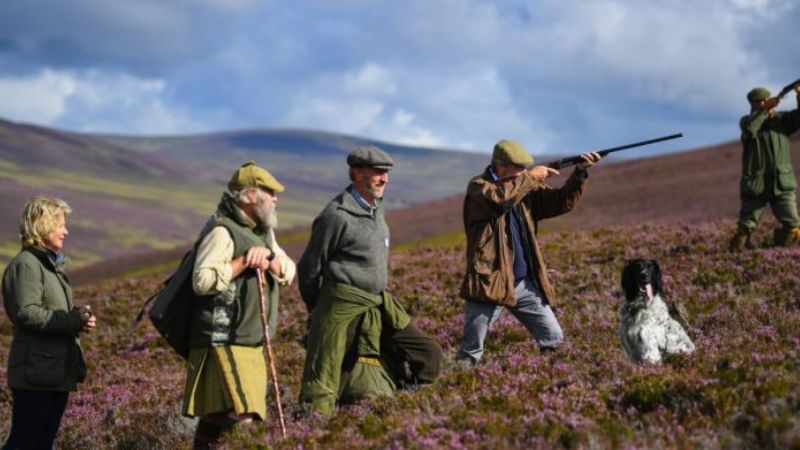Wildlife campaigners are calling for even tougher policing of Scottish grouse moors on the eve of this year’s “Glorious Twelfth”, which marks the legal start of the grouse shooting season.
On Monday 12 August moors across the British uplands will echo to the sound of shotguns and estate vehicles.
But for the first time, grouse moors in Scotland must hold a licence for shooting under new powers brought in earlier this year to reduce the unlawful killing of birds of prey by gamekeepers.
Data compiled by the Royal Society for the Protection of Birds (RSPB) shows there were 488 persecution incidents in Scotland from 2007 to 2022 involving shooting, poisoning, snaring, trapping and nest destruction of birds of prey.
The new licences, which last for five years and are overseen by the government agency NatureScot, came into force last month. Grouse moors face losing their legal authority to shoot grouse if their estates or employees are linked to the deaths of birds of prey.
Prof Colin Galbraith, an ecologist with expertise in bird of prey persecution who chairs NatureScot’s board, said he was “genuinely optimistic” the legislation would improve wildlife conservation on grouse moors.
Owners were already proactively counting birds of prey on their estates and improving habitats. The new regime encourages positive management and has brought in accountability.
“Many, many landowners are aware of the need to change their practices,” he said. “This is an opportunity to prove how good [they] can be.”
In time, these powers could also influence the Labour government in London to start controlling persecution on English grouse moors much more effectively, he said, perhaps by commissioning something similar to the groundbreaking review headed by Prof Alan Werritty that recommended Scotland’s new law.
But animal welfare and conservation charities want Scotland’s laws to be extended further in order to accurately map the full ecological impact of grouse shooting on wildlife. They say the new rules, which only require shoots to count the number of grouse killed annually, are not sufficient.
Revive, a coalition of wildlife charities that opposes grouse shooting, and the RSPB are calling on ministers to force gamekeepers to also count the stoats, foxes, weasels and crows killed each year to protect grouse chicks.
Robbie Marsland, the director of the League Against Cruel Sports Scotland, said its calculations suggested between 120,000 and 260,000 wild animals were shot or killed by traps and snares on grouse moors each year – many of which do not eat grouse.
The Wildlife Management and Muirburn Act 2024 will also ban the use of snares from later next year, and require training to use certain traps, but Marsland said it only partially reduced the “circle of destruction” surrounding grouse moors.
He said licensing suggested Scotland was “on a journey” to eventually outlawing an industry which, he said, believed “it’s OK to kill hundreds of thousands of other animals to protect birds simply so they can also be killed”.
The introduction of licensing, which was strongly resisted by the country sports sector, has already been overshadowed by a dispute between the industry and NatureScot over the area of land covered by the licences.
Scottish Land & Estates, the body for landowners, and other groups such as the Game and Wildlife Conservation Trust are angered by NatureScot’s decision on the area of land that will be covered.
They and the British Association for Shooting and Conservation (BASC) want NatureScot to restrict the licensable area simply to grouse moors where shooting takes place. They argue it is unnecessary and unfair to include parts of a farm or estate not involved in game shooting.
They have advised some of their members to hold off applying for licences until the rules are confirmed, and have been mulling legal action.
Peter Clark, the Scotland director for the BASC, said NatureScot had rushed into implementing shooting licences a year before all the act’s other measures were in force, without taking the time to prepare properly. “We envisaged something would go wrong, and something has,” he said.
While it has not yet said what failings would trigger the revocation of a licence, NatureScot has signalled its intention to police grouse moors vigorously. It has banned five grouse moors from killing wild birds this year because of police intelligence of bird persecution – the highest number on record.
Galbraith said an estate that was upholding the law had nothing to fear from being entirely covered by a licence. “If they’re not doing anything wrong, why worry about it?”
This article by Severin Carrell was first published by The Guardian on 10 August 2024. Lead Image: Grouse moors face losing their legal authority to shoot grouse if their estates or employees are linked to the deaths of birds of prey. Photograph: Jeff J Mitchell/Getty Images.
What you can do
Help to save wildlife by donating as little as $1 – It only takes a minute.




Leave a Reply